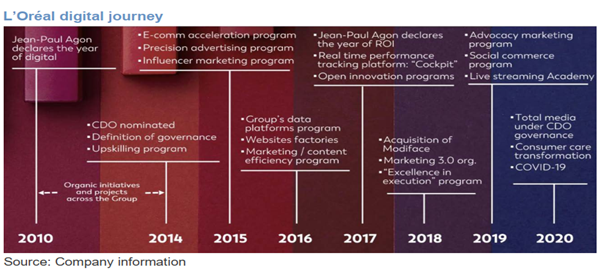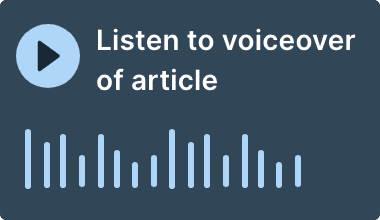The technology sector is a dominant force in today’s stock market, representing nearly 30 per cent of the S&P 500 by market capitalisation. 1 While investors are understandably drawn to the cutting-edge technologies of these companies, they might be overlooking their competitive advantages in traditional operational areas such as sales and distribution. In the past, we have discussed how Google, a tech giant, harnessed the power of distribution to create formidable barriers to entry. This newsletter shifts our attention to non-tech companies, specifically those predating the digital age and how these players can harness digital technology to stay ahead of competition.
L’Oréal, a household name synonymous with beauty staples like skincare, haircare, makeup, and perfume, requires little introduction. Well-known for its marketing prowess, this century-old giant, amid rapid changes in a digital era, has not only survived, but thrived and solidified its position as a global leader in the beauty sector today. Its global market share has increased from ~8 per cent in the early 2000s to nearly 15 per cent today, accompanied by an operating margin going from low teens to nearly 20 per cent. Not everyone may expect that digital technology has played a key role behind its recent success.
2010 was the year that L’Oréal declared its ‘digital emergency’, setting its vision to become a ‘digital-first’ company. At the time, digitalisation was only emerging in the beauty industry. L’Oréal was not falling behind in technology by any means; it had already built IT infrastructure and integrated information technology into its daily operations, including online advertising with consumers who were already using the internet for everything in their daily life, from searching product information to posting pictures on social media. But L’Oréal’s management saw far more potential for new technologies. In the subsequent decade, the company gradually built a digital culture, integrating ‘digital’ into every aspect of its business model. Their digital strategy also gradually evolved beyond being merely digital-first, into becoming a pioneer of Beauty Tech.
Figure 1: L’Oréal’s digital journey 2010-20202

One of the key challenges the beauty industry has always faced is anticipating demand, because of constantly evolving consumer tastes, fashions and preferences. L’Oréal has developed a system called TrendSpotter to help them do the job better. TrendSpotter collects millions of relevant data points online, such as posts, articles, images and even audio and video clips across the web and social media. Then the system uses artificial intelligence and machine learning to analyse data and distil patterns that can identify beauty trends at a very early stage, and simultaneously help the company answer three key questions: ‘What’s hot now?’, ‘What’s new?’ and ‘What’s next?’ These patterns are then turned over to human experts who assess whether these patterns represent trends that can be useful for L’Oréal’s product development and marketing teams. As Charles Besson, Global Social Insights and AI Director at L’Oréal puts it, “The main idea is to make sure we can detect before the competition the trends of tomorrow.”3This is a point made all the more important by the fact that it takes about a year to turn a concept into a product that sits on store shelves. Spotting a trend months earlier than rivals can give L’Oréal a significant advantage. This information also feeds into marketing and consumer intelligence teams so that they can use the ‘right’ content that comes directly from the consumer voice to resonate and connect back with consumers.
TrendSpotter was only one application developed under L’Oréal’s ‘Demand Sensing’ initiative. With this broader initiative, the company has also transformed its Sales and Operations (S&OP) process, which aligns sales, marketing and finance functions with the supply chain. This system compiles demand plans from each of the 150 countries in which L’Oréal is present, then calculates and consolidates corresponding supply needs (from raw materials to packaging components), defines factory production plans (for 40 manufacturing plants around the world) and even shop floor scheduling, all in a single tool. However, to unlock the true value that such a fancy tool can offer, the key is data. But as the classic IT expression puts it, “Garbage in, Garbage out.” The scope, time scale, and granularity of the data inputs needed are vast and knowing this, L’Oréal has, for at least a decade, made continuous efforts to invest and improve data programs and platforms.
For example, in an earlier stage, the system used purely historical and internal data. Now it also integrates data from external sources, notably suppliers, using a Cloud platform (Platform-as-a-Service), which shares all raw material and components requirements with the company’s huge vendor base4 in real-time. The platform also integrates sales data from sell-in (orders in distribution) and sell-out (actual consumer demand), as well as direct online and DTC (direct-to-consumers) physical stores. Deploying machine learning on all of this data can automate demand planning calculations. In addition, any shifts or changes of demand in the market or throughout the supply chain are detected and quickly propagate all the way to affect decisions in stock deployment, inventory, procurement and production lines in real-time. ‘Demand Sensing’ initiatives have significantly improved demand planning accuracy, lowered product development and GTM (go-to-market) time, and simultaneously reduced manual intervention in the process (estimated by 50%). The success of the company’s supply chain management has also been noticed externally. Gartner, a global technological research and consulting firm, provides an annual ranking of the top supply chains in the world. While L’Oréal was ranked 71st in the world in 2012, in 2020 it finished in the top 10 for the first time.
‘Demand sensing’ is but one of many initiatives under L’Oréal’s expansive ‘Beauty Tech’ vision. This vision aims to transform the beauty industry beyond products to a variety of services, such as diagnostics, consumer experience, personalisation, and more. Discussing the full picture of “Beauty Tech’ is far beyond this newsletter’s scope. But hopefully, these simple examples showcase a number of benefits that technology can bring today. TrendSpotter helps L’Oréal to detect and act on consumer trends swiftly and effectively. A tech-powered supply chain enables agile manufacturing and distribution to address ever-increasing demand volatility. This not only boosts efficiency and resilience but also reduces costs and accelerates product launches. Perhaps more broadly, we hope L’Oréal serves as an example that technology can be harnessed to become a key source of competitive advantage for some of today’s best-run non-tech companies.
N. Yu,
29 February 2024
- This understates the real weight of technology companies in the economy, as many tech companies are not classified in the tech sector. For example, Google is in “communication services” and Amazon is in “consumer discretionary.” This is one of the reasons why we find sector classification can be misleading, as we outlined in this newsletter. ↩︎
- https://www.imd.org/research-knowledge/supply-chain/case-studies/l-oral-the-beauty-of-supply-chain-digitalization/ ↩︎
- https://www.digitalcommerce360.com/2022/02/24/how-loreal-uses-ai-to-stay-ahead-of-its-competition/ ↩︎
- L’Oréal has over 50,000 suppliers upstream, and 500,000 delivery points downstream. ↩︎
Any forecasts, opinions, goals, strategies, outlooks and or estimates and expectations or other non-historical commentary contained herein or expressed in this document are based on current forecasts, opinions and or estimates and expectations only, and are considered “forward looking statements”. Forward-looking statements are subject to risks and uncertainties that may cause actual future results to be different from expectations. Nothing in this newsletter is a recommendation for a particular stock. The views, forecasts, opinions and or estimates and expectations expressed in this document are a reflection of Seilern Investment Management Ltd’s best judgment as of the date of this communication’s publication, and are subject to change. No responsibility or liability shall be accepted for amending, correcting, or updating any information or forecasts, opinions and or estimates and expectations contained herein.
Please be aware that past performance should not be seen as an indication of future performance. Any financial instrument included in this website could be considered high risk and investors may not get back all of their original investment. The value of any investments and or financial instruments included in this website and the income derived from them may fluctuate and you may not receive back the amount originally invested. In addition stock market fluctuations and currency movements may also affect the value of investments.
Get the latest insights & events direct to your inbox
"*" indicates required fields





